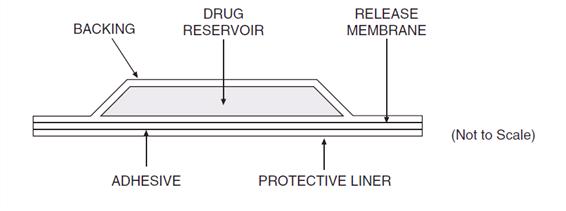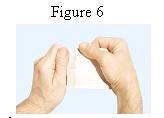FENTANYL TRANSDERMAL SYSTEM- fentanyl patch
Actavis South Atlantic LLC
----------
MEDICATION GUIDE
Fentanyl Transdermal System, CII
Rx only
Fentanyl Transdermal System is:
- A strong prescription pain medicine that contains an opioid (narcotic) that is used to treat moderate to severe around-the-clock pain, in people who are already regularly using opioid pain medicine.
Important information about Fentanyl Transdermal System:
- Get emergency help right away if you use too much Fentanyl Transdermal System (overdose). Fentanyl transdermal system overdose can cause life threatening breathing problems that can lead to death.
- Never give anyone else your fentanyl transdermal system. They could die from using it. Store fentanyl transdermal system away from children and in a safe place to prevent stealing or abuse. Selling or giving awayfentanyl transdermal system is against the law.
Do not use Fentanyl Transdermal System if you have:
- severe asthma, trouble breathing, or other lung problems.
- a bowel blockage or have narrowing of the stomach or intestines.
Before applying Fentanyl Transdermal System, tell your healthcare provider if you have a history of:
- head injury, seizures● liver, kidney, thyroid problems
- problems urinating ● pancreas or gallbladder problems
- abuse of street or prescription drugs, alcohol addiction, or mental health problems.
Tell your healthcare provider if you:
- have a fever
- are pregnant or planning to become pregnant. Fentanyl may harm your unborn baby.
- are breastfeeding. Fentanyl passes into breast milk and may harm your baby.
- are taking prescription or over-the-counter medicines, vitamins, or herbal supplements.
When using Fentanyl Transdermal System:
- Do not change your dose. Apply fentanyl transdermal system patch exactly as prescribed by your healthcare provider.
- See the detailed Instructions for Use for information about how to apply and dispose of the fentanyl transdermal system patch.
- Do not wear more than 1 patch at the same time unless your healthcare provider tells you to.
- Call your healthcare provider if the dose you are using does not control your pain.
- Do not stop using fentanyl transdermal system without talking to your healthcare provider.
While using Fentanyl Transdermal System Do Not:
- Take hot baths or sunbathe, use hot tubs, saunas, heating pads, electric blankets, heated waterbeds, or tanning lamps, or engage in exercise that increases your body temperature. These can cause an overdose that can lead to death.
- Drive or operate heavy machinery, until you know how fentanyl transdermal system affects you. Fentanyl transdermal system can make you sleepy, dizzy, or lightheaded.
- Drink alcohol or use prescription or over-the-counter medicines that contain alcohol.
The possible side effects of Fentanyl Transdermal System are:
- constipation, nausea, sleepiness, vomiting, tiredness, headache, dizziness, abdominal pain, itching, redness, or rash where the patch is applied. Call your healthcare provider if you have any of these symptoms and they are severe.
Get emergency medical help if you have:
- trouble breathing, shortness of breath, fast heartbeat, chest pain, swelling of your face, tongue or throat, extreme drowsiness, or you are feeling faint.
These are not allthe possible side effects of fentanyl transdermal system. Call your doctor for medical advice about side effects. You may report side effects to FDA at 1-800-FDA-1088. For more information go to dailymed.nlm.nih.gov. For questions concerning this product, please call Actavis at 1-877-422-7452.
This Medication Guide has been approved by the U.S. Food and Drug Administration.
Issue July 2012
Distributed by:
Actavis South Atlantic LLC
13800 N.W. 2nd Street, Suite 190
Sunrise, FL 33325 USA
Manufactured by:
Corium International, Inc.
Grand Rapids, MI 49512
CAW0808
(MG-0712)
Fentanyl Transdermal System CII
Instructions for Applying a Fentanyl Transdermal System

Before Applying Fentanyl Transdermal System
- Each fentanyl transdermal system is sealed in its own protective pouch. Do not remove a fentanyl transdermal system from the pouch until you are ready to use it.
- Do not use a fentanyl transdermal system if the pouch seal is broken or the patch is cut, damaged or changed in any way.
- Fentanyl transdermal system is available in 4 different doses and patch sizes. Make sure you have the right dose patch or patches that have been prescribed for you.
Applying a Fentanyl Transdermal System
1. Skin Areas Where the Fentanyl Transdermal System May Be Applied:
For adults:
- Put the patch on the chest, back, flank (sides of the waist), or upper arm in a place where there is no hair (see Figures 1-4).
For children (and adults with mental impairment):
- Put the patch on the upper back (see Figure 2). This will lower the chances that the child will remove the patch and put it in their mouth.

For adults and children
- Do not put a fentanyl transdermal system on skin that is very oily, burned, broken out, cut, irritated, or damaged in any way.
- Avoid sensitive areas or those that move around a lot. If there is hair, do not shave (shaving irritates the skin). Instead, clip hair as close to the skin as possible (see Figure 5).

- Talk to your doctor if you have questions about skin application sites.
2. Prepare to Apply a Fentanyl Transdermal System:
- Choose the time of day that is best for you to apply fentanyl transdermal system. Change it at about the same time of day (3 days or 72 hours after you apply the patch) or as directed by your doctor.
- Do not wear more than one fentanyl transdermal system at a time unless your doctor tells you to do so. Before putting on a new fentanyl transdermal system, remove the patch you have been wearing.
- Clean the skin area with clear water only. Pat skin completely dry. Do not use anything on the skin such as soaps, lotions, oils, or alcohol before the patch is applied.
3. Open the Pouch:DO NOT CUT. Fold and tear at slit and remove the fentanyl transdermal system. Each fentanyl transdermal system is sealed in its own protective pouch. Do not remove the fentanyl transdermal system from the pouch until you are ready to use it (see Figure 6).

4. Peel: Peel the liner from the back of the patch and throw away. Touch the sticky side of the fentanyl transdermal system as little as possible (see Figure 7).

5. Press: Press the patch onto the chosen skin site with the palm of your hand and hold there for at least 30 seconds (see Figure 8). Make sure it sticks well, especially at the edges.

- Fentanyl transdermal system may not stick to all patients. You need to check the patches often to make sure that they are sticking well to the skin.
- If the patch falls off right away after applying, discard it properly (see “Disposing a Fentanyl Transdermal System”)and put a new one on at a different skin site.
- If you have a problem with the patch not sticking
- Apply first aid tape only to the edges of the patch.
- If you continue to have problems with the patch sticking, you may cover the patch with Tegaderm™. These are special see-through adhesive dressings. Never cover a fentanyl transdermal system with any other bandage or tape. Remove the backing from the Tegaderm™ dressing and place it carefully over the fentanyl transdermal system, smoothing it over the patch and your skin.
- If your patch falls off later, but before 3 days (72 hours) of use, discard it properly (see “Disposing a Fentanyl Transdermal System”) and put a new one on at a different skin site. Be sure to let your doctor know that this has happened, and do not replace the new patch until 3 days (72 hours) after you put it on (or as directed by your doctor).
6. Wash your hands when you have finished applying a fentanyl transdermal system.
7. Remove a fentanyl transdermal system after wearing it for 3 days (72 hours) (see “Disposing a Fentanyl Transdermal System”). Choose a different place on the skin to apply a new fentanyl transdermal system and repeat Steps 2 through 6.
Do not apply the new patch to the same place as the last one.
Water and Fentanyl Transdermal System
- You can bathe, swim or shower while you are wearing a fentanyl transdermal system. If the patch falls off before 3 days (72 hours) after application, discard it properly (see “Disposing a Fentanyl Transdermal System”) and put a new one on at a different skin site. Be sure to let your doctor know that this has happened, and do not replace the new patch until 3 days (72 hours) after you put it on (or as directed by your doctor).
Disposing a Fentanyl Transdermal System
- Fold the used fentanyl transdermal system in half so that the sticky side sticks to itself (Figure 9). Flush the used fentanyl transdermal system down the toilet right away (Figure 10). A used fentanyl transdermal system CAN be VERY dangerous for or even lead to death in babies, children, pets, and adults who have not been prescribed fentanyl transdermal system.

- Throw away any fentanyl transdermal systems that are left over from your prescription as soon as they are no longer needed. Remove the leftover patches from their protective pouch and remove the protective liner. Fold the patches in half with the sticky sides together, and flush the patches down the toilet. Do not flush the pouch or the protective liner down the toilet. These items can be thrown away in a trashcan.
TegadermTM is a trademark of 3M
Rx Only
Manufactured by:
Corium International, Inc.
Grand Rapids, MI 49512
Distributed by:
Actavis South Atlantic LLC
13800 N.W. 2nd Street, Suite 190
Sunrise, FL 33325 USA
Revised – June 2012
CA0806